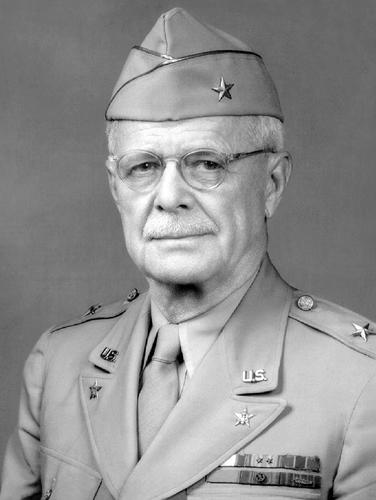

John M. A. Palmer
Commanding Officer 22nd Infantry
June 11, 1920 - May 5, 1921
"Colonel
John M.A. Palmer was assigned to the command of the 22nd US
Infantry Regiment on June 11, 1920,
and joined June 19. Colonel Palmer had previously been on duty
with the general staff of the War Department,
in which capacity he had done a great deal of work with the
Senate Committee on Military Affairs, appearing
before that body on several occasions to present the views of the
general staff on army reorganization,
particularly those phases bearing on the creation of a Chief of
Infantry and the adoption of
a single promotion list for all officers.
On May 5, 1921
Colonel Palmer left the regiment to become Aide de Camp to the
General of the Armies,
General John Pershing." ¹
John McAuley Palmer was born in Carlinville, Macoupin County, Illinois on April 23, 1870.
At the age of eighteen he
entered the US Military Academy on June 16, 1888. On June 11,
1892 he graduated 19
out of a class of 62. His best subjects were History and
Chemistry and his worst subjects were Spanish and Civil
Engineering.
He was the Captain of Company B of the Battalion Organization of
Cadets. Upon graduation he was commissioned a
2nd Lieutenant in the 15th Infantry assigned to Company F.
Palmer served on garrison duty
at Fort Sheridan, Illinois from September 30, 1892 to October 22,
1896. He was then stationed
with the Regiment at Fort Grant, Arizona until December 30, 1897.
From June 1 to September 1, 1897 he was on Special
Topographical duty in southeastern Arizona. On January 1, 1898 he
began a detail as Professor of Military Science and Tactics
at the University of Chicago. On April 26, 1898, he was promoted
to 1st Lieutenant.
With the declaration of war
against Spain his detail at the university was curtailed on May
26, 1898 and he was assigned as part
of an Army board in Chicago, Illinois purchasing horses for the
volunteer cavalry. He performed this duty from May 26 to
June 30, 1898. From June 21 to August 9, 1898 he was the
mustering officer for one of the US Volunteer Infantry Regiments
classified as "Immunes" which were made up of
volunteers supposedly immune to the tropical diseases which
Soldiers were
expected to encounter in the war zone of Cuba, Puerto Rico and
the Philippines.
Palmer was on garrsion duty at
Fort Logan, Colorado from August 14 to September 4, 1898. From
September 4, 1898
to February 24, 1899 he was detailed as Aide-de-camp to Brigadier
General Edwin Vose Sumner Jr., who was the
Commander of both the Department of the Missouri and the
Department of Colorado. From February 24 to March 24, 1899
he remained on temporary duty at the Headquarters of the
Department of the Missouri.
From March 24, 1899 Palmer was
officially enroute to rejoin his Regiment, eventually serving
with it in Cuba on occupation
duty. From September to December 20, 1899 he was the Acting Chief
Quartermaster, District of Puerto Principe, Cuba.
He returned with the 15th Infantry to Plattsburg Barracks, New
York where he served from January 1 to July 10, 1900.
From July 10 to November 26,
1900 Palmer served as part of 1st Battalion 15th Infantry in the
China Relief Expedition,
on duty in the Tientsin area and up the Pei Ho River to Peking.
Leaving China on November 26, 1900 he returned to
garrison duty at Fort Porter, New York. He was promoted to
Captain of the 15th Infantry on February 2, 1901, assigned
to Company D. However, that Company was on duty in the
Philippines and Palmer did not join it.
He was detailed as Instructor of
Chemistry at the US Military Academy at West Point on August 27,
1901.
During the year 1902 Palmer was officially assigned to Company K
of the 15th Infantry, though he remained
on duty at West Point. His initial detail to the Academy ended on
August 15, 1905 but he stayed on at West Point
for another year as Assistant Professor of Chemistry, leaving the
Academy on August 15, 1906.
From August 15 to October 21,
1906 Palmer was officially "en route" to join his
regiment which was then on duty
in the Philippines. On October 21 he rejoined the regiment at
Camp Keithley on the island of Mindanao. From
November 11, 1906 to September 15, 1907 he was the Governor of
the District of Lanao, Mindanao, Philippine Islands.
He took sick leave from September 12 to November 20, 1907, at
which time he joined his regiment at Nagasaki, Japan,
en route to the United States.
Palmer served with the 15th
Infantry at Fort Douglas, Utah from December 18, 1907 to June 1,
1908.
From June of 1908 to June of 1909 he attended the Army's School
of the Line at Fort Leavenworth, Kansas,
from which he became an Honor Graduate. From June of 1909 to June
of 1910 he attended the Army Staff College,
graduating from that course. He then went on "Staff
Ride", visiting various maneuver camps from July to
September, 1910.
Palmer rejoined his regiment in
October 1910 and served with it at San Antonio, Texas through
February 1911.
The 15th Infantry became part of the Maneuver Division in March
1911 and Palmer was assigned as Adjutant of
the Maneuver Division's 2nd Brigade from March to April of 1911.
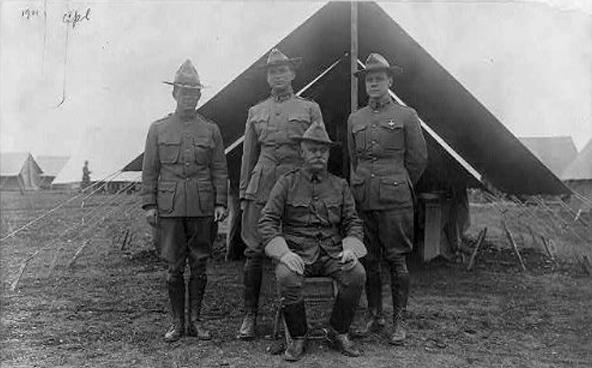
April 1911 San Antonio,
Texas.
The Staff of the 2nd Brigade of the Maneuver Division.
John McAuley Palmer is on the far left, as a Captain of the 15th
Infantry and
Adjutant of 2nd Brigade of the Manuever Division.
In the center seated is
Brigadier General Marion P. Maus, Commander of 2nd Brigade. Maus
had been
the Lieutenant Colonel of the 22nd Infantry from 1902-1904 and
had temporarily commanded
the 22nd Infantry Regiment in 1903 and 1904.
Photo from the Library of Congress: LC-USZ62-76985
In May of 1911 Palmer left the
assignment with the Maneuver Division and reported to Washington,
D.C.
On June 8, 1911 he was officially detailed to the General Staff
Corps. He remained at Washington until
December 1, 1911, then travelled to Europe where he was an
observer of maneuvers being held in both
France and Germany during 1912. Also during 1912 he was a cadre
at the Army War College.
|
Newspaper article describing In an eerie prophecy of things
to come Two years later the German army
fought that war At the bottom of the article
John McAuley Palmer San Francisco Call, Tuesday, September 10, 1912 |
On September 1, 1912 Palmer was
relieved from the detail to the General Staff.
After some leave time, on March 1, 1913 he rejoined his regiment,
then at Tientsin, China.
On June 5, 1914 Palmer was
promoted to Major 24th Infantry. On July 20, 1914 he left the
15th Infantry
and on August 1 of that year joined the 24th Infantry at their
duty station in the Philippines. He served at
Corregidor and Manila and from November 1914 to September 15,
1915 he was a member of the
Board of Defense of the Philippine Islands. He returned with the
regiment to the United States and
served with it at the Presidio of San Francisco, California from
October 12, 1915 to January 8, 1916.
Palmer was detailed to the
General Staff Corps on January 30, 1916 where he was listed (for
General Staff purposes only)
as a Colonel of the General Staff. On May 15, 1917 he was
promoted in the regular Army to Lieutenant Colonel of Infantry.
On May 20, 1917 he was assigned as Assistant Chief of Staff of
the American Expeditionary Forces in Europe.
On August 5, 1917 Palmer was
promoted to Colonel, Temporary, of Infantry. He left his position
as Assistant
Chief of Staff on November 1, 1917 and from November 10, 1917 to
February 20, 1918 he was at Lyons and
Langres, France on Military School duty. He was on sick leave
from May 3 to October 21, 1918.
From October 12 to December 24,
1918 Palmer commanded the 58th Infantry Brigade of the 29th
Division
and participated in the Meuse-Argonne Offensive. On January 31,
1919 he was assigned to the War Plans Division
of the General Staff. On July 1, 1919 he was made Chief of the
War Plans Branch. He was detailed to special duty
with the Military Affairs Committee of the US Senate on November
1, 1919.
Palmer was honorably discharged
from his Temporary Colonel rank on March 15, 1920
and returned to the grade of Lieutenant Colonel.
On June 11, 1920 Palmer was
assigned as Commander of the 22nd Infantry, accepting the
position on June 19 of that year.
On June 20, 1920 he was officially promoted to Colonel in the
regular Army. He commanded the 22nd Infantry at Fort Jay,
New York until May 5, 1921.
He left the 22nd Infantry to
become the Aide-de-camp to General of the Armies John J. Pershing
on May 5, 1921.
He was a member of the Technical Staff at the Conference on
Limitation of Armaments in Washington, D.C. from
November 10, 1921 to February 6, 1922.
He was offered a promotion to
Brigadier General on December 2, 1922, which he accepted on
December 4 of that year.
He continued as Pershing's Aide until August 1, 1923.
Palmer commanded the 19th
Infantry Brigade at Gatun in the Panama Canal Zone from September
14, 1923 to
November 1, 1925. (From May 14 to November 1, 1925 he was absent
on sick leave.)
He retired from the Army on January 18, 1926 and was given a disability in the line of duty.
On November 14, 1941 Palmer was
recalled to active duty and served on the General Staff as
Advisor on Military Policy to the War Department until September
27, 1946.
He died in Washington, D.C. on October 26, 1955.
John McAuley Palmer was awarded
the French Legion of Honor and Croix de Guerre and the
Italian Order of St. Maurice and St. Lazarus. He was a member of
the Military Order of the Dragon.
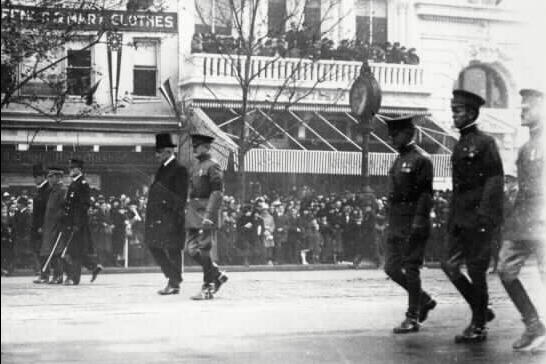
11 November 1921, the procession of the burial of the Unknown Soldier at Arlington Cemetery.
Colonel John M.A. Palmer
is third from the right; at this time he was the Aide-de-Camp to
General John Pershing.
Next to Palmer is George C. Marshall and next to Marshall is John
G. Quekemeyer, both of whom were also Aides to Pershing.
General Pershing is center, walking with President Harding.
US Army photo
John McAuley Palmer
Born in
Carlinville, Illinois, on April 23, 1870, he was the grandson and
namesake of John McAuley Palmer,
a famous American Civil War general and Governor of Illinois. He
graduated as a 2d lieutenant of infantry
in 1892, and served with the 15th US Infantry at Fort Sheridan,
Illinois. He participated in the suppression
of the Chicago railroad riots of 1894, ........... he became a
member of the China Relief Expedition
(1900-1901), then an instructor and assistant professor of
chemistry at West Point (1901-1906).
Following this
academic stint, he was then assigned a billet as a district
governor in the Lanao District
on Mindanao in the Philippines (1906-1908). Upon return from Far
East Service, he was a student
at Fort Leavenworth, Kansas and then assigned to the War
Department General Staff under the command
of the then-Army Chief of Staff Major General Leonard Wood
(1908-1910). During this period of service
he received recognition as a thinker and writer. .............was
promoted to the permanent rank of major.
He was then transferred to the 24th Infantry on Corregidor and
was instrumental in creating the plans for the
defense of the Bataan Peninsula (1914-1916).
Following this
assignment, he returned to the General Staff in Washington, D.C.
(1916) and on the outbreak
of the First World War was instrumental in drafting the Draft Act
of 1917 and plans for an
American Expeditionary Force (AEF). This work caught the notice
of General John J. Pershing,
who selected Palmer to become his Assistant Chief of Staff, G-3,
where he went to France and set up
operational plans and staff schools for the American Army. He
left the AEF staff due to illness,
but recovered in time, as a colonel, to command the 58th Infantry
Brigade of the 29th Division in combat
against the enemy at Verdun in the Meuse-Argonne Offensive that
helped to end World War I.
As the principal
formulator of military policy following World War I, he was the
guiding force
in the creation of the National Defense Act of 1920. It was this
Act which reaffirmed America's reliance
upon the citizen-soldier for her defense and established the
"Total Army" composed of the Regular Army,
the National Guard, and the Army Reserve. For his
accomplishments, he was made a special advisor
to General of the Armies John J. Pershing (1921-1923) and
promoted to permanent brigadier general
in the Regular Army (1922). He then completed his military career
by commanding a brigade in Panama (1924-1926).
In retirement
(1926), General Palmer continued to champion the cause of
military service.
He wrote numerous books and articles about military policy. He
was recalled to active duty by
Army Chief of Staff George C. Marshall (a personal friend and
devotee of Palmer's) just prior
to the Pearl Harbor attack and served as an advisor on military
policy to the War Department General Staff
throughout World War II. He retired quietly soon after the end of
the Second World War
and lived quietly in Washington, D.C. where he died on October
26, 1955.
He is buried in Arlington Cemetery.
A strong advocate
of the role of the citizen-soldier in the army of a democracy,
Palmer diverged
from the views of Emory Upton, with whom he is often compared as
a great philosophical
thinker-philosopher of the U.S. Army.
²
|
Brigadier General John M.A. Palmer Photo taken during the Second World War. General Palmer was the oldest
American When the war ended in 1945, |
The citations for John McAuley Palmer's two Distinguished Service Medals are:
War Department General Orders No. 12 (1919)
For exceptionally meritorious
and distinguished services. In the organization of the operations
section of the General Staff,
American Expeditionary Forces, this officer displayed sound
tactical judgment and breadth of vision, and the ultimate success
of the American plan of campaign was largely due to his detailed
plans. As Commander of the 58th Infantry Brigade during the
severe fighting north of Verdun, in the Argonne-Meuse offensive,
his services were conspicuous and his brigade successful.
War Department General Orders No. 115 (1945)
Brigadier General John McAuley
Palmer, United States Army, was awarded a Bronze Oak Leaf Cluster
in lieu of a Second Award
of the Army Distinguished Service Medal for exceptionally
meritorious and distinguished services to the Government of the
United States,
in a duty of great responsibility as General Staff Advisor on
Military policy.
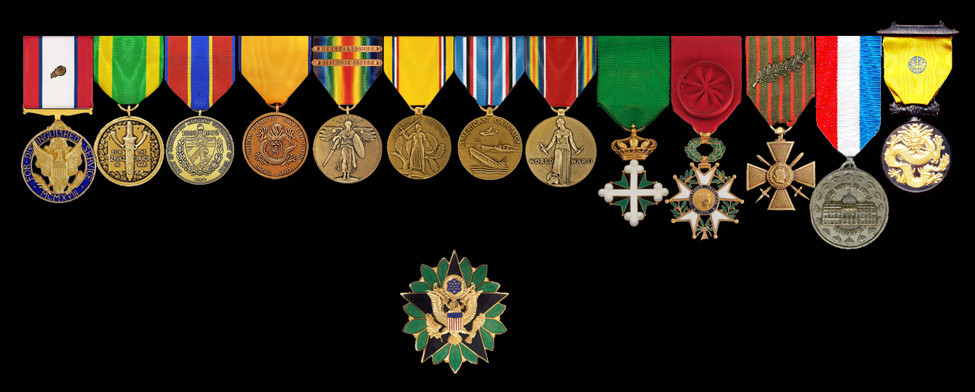
John McAuley Palmer's decorations
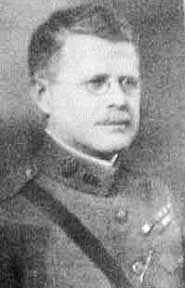
This portrait of Colonel Palmer hung on
the wall at 1st Battalion 22nd Infantry Headquarters
at Fort Hood, Texas, 1999-2009.
His age, uniform and decorations all
indicate this photo was taken between 1919 and 1926,
and quite possibly during his Command of the 22nd Infantry.
Photo courtesy of Major Anne LeGare,
wife of LTC Marc LeGare,
Commanding Officer 1-22 IN 1999-2001.
From the Library of Congress, here are the main biographical notes of John McAuley Palmer:
1870, 23 April
----------------------------------------------------------------------------------------------
Born, Carlinville, Ill.
1892
-------------------------------------------------------------
B.S., United States Military Academy, West Point, N.Y.
Commissioned second lieutenant, Fifteenth Infantry Regiment
1893
-------------------------------------------------------------------------------------------------------
Married Maude Laning
1899
-------------------------------------------------------------------------------------
Assigned to occupation duty in Cuba
1900 --------------------------------------------------- Served
in the China Relief Expedition during the Boxer Rebellion
1901-1906 -------------------------------- Instructor of
chemistry, United States Military Academy, West Point, N.Y.
1906-1907
-----------------------------------------------------------------------
Governor, Lanao district, Philippine Islands
1908-1910 ------ Student, United States Army School of the Line
and the Staff College, Fort Leavenworth, Kans.
1911-1912 ----- Served on the Army General Staff where he
proposed tactical reorganization of the United States
Army---------------------------------------------------------------------
1916 ------------------------------ Published An Army of the
People. New York and London: G. P. Putnam’s Sons
1916-1920 --------------- Returned to the Army General Staff and
participated in the organization of the American
Expeditionary Forces-------------------------------------------------
1917
--------------------------------------------------------------------------------
Assisted in writing the Draft Act of 1917
------------------------------Selected by John J. Pershing as assistant chief of staff
for operations for the American
Expeditionary Forces
1918 ----------------- Commanded the Fifty-eighth Infantry
Brigade of the Twenty-ninth Division in assault of the
Hindenburg line north of Verdun------------------------------------
1919-1920
-------------------------------------------------------- Military
adviser, Senate Committee on Military Affairs
1920
----------------------------------------------------------------------------
Assisted in writing the Defense Act of 1920
1920-1921
---------------------------------------------------------------------------
Commander 22nd Infantry Regiment *
1921-1923
---------------------------------------------------------------------------------
Aide-de-camp to John J. Pershing
1922
---------------------------------------------------------------------------------------------
Promoted to brigadier general
1923-1925 ---------------------------------------------
Commander, Nineteenth Infantry Brigade, Canal Zone, Panama
1926
-------------------------------------------------------------------------------------------------------------------------
Retired
1927 --------------------------------- Published Statesmanship or
War. Garden City, N.Y.: Doubleday, Page & Co.
1930 ---------------------- Published Washington, Lincoln,
Wilson. Garden City, N.Y.: Doubleday, Doran & Co.
1937 ------------------------------------- Published General von
Steuben. New Haven, Conn.: Yale University Press
1940
---------------------------------------------------------------
Assisted in writing the Selective Service Act of 1940\
1941 ------------------------------------- Published America in
Arms. London: H. Milford, Oxford University Press
1941-1946 ----------------------------------------------------
Recalled to active duty as adviser to George C. Marshall
1955, 26 October
-----------------------------------------------------------------------------------
Died, Washington, D.C.
* Entry added by the website editor
Throughout his life Palmer was prolific in historical research and writing and was the author of:
An Army of the People published by G.P. Putnam's Sons 1916
Statesmanship Or War published by Doubleday 1927
Washington, Lincoln, Wilson; Three War Statesmen published by Doubleday 1930
General Von Steuben published by Yale University Press 1937
America In Arms published by Arno Press 1941
America in Arms is his
best known and most important work.
For an excellent review of America In Arms, click on the
following link:
The John McAuley Palmer papers
are in the collection of the Library of Congress, as ID no.
MSS35402.
In that file are 8,750 items, plus 1 artifact, that artifact
being Palmer's Medal of the National Circle of the Armies
of Land Air and Sea (Médaille du Cercle National des Armées de
Terre, Air et Mer).
In 2005 John McAuley Palmer was
inducted into the Army's Force Development Hall of Fame.
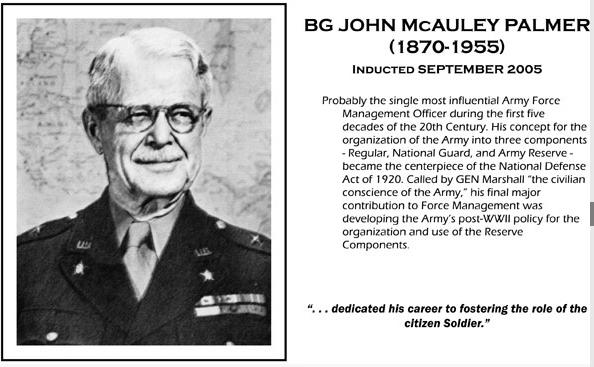
Graphic from the Official Homepage of Functional Area 50
John McAuley Palmer is buried at Arlington National Cemetery
Section 34 Grave 50-A
He was interred on October 27, 1955
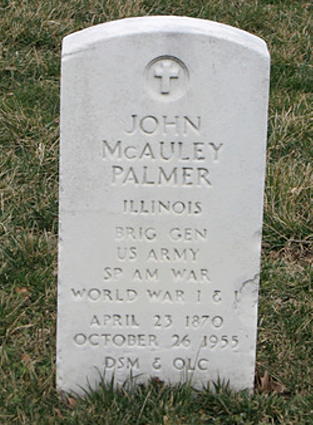
General Palmer's grave marker at Arlington Cemetery
Photo from the Find A Grave website
Top photo of John McAuley Palmer as a Brigadier
General, and member of the General Staff, during his World War II
recall from retirement, 1944.
Reprinted in Office of Army Reserve History's 2004 report
"Chiefs of the Army Reserve: Biographical Sketches of the
United States
Army Reserve's Senior Officers".
Photo by U. S. Army Signal Corps.
¹ HISTORY OF THE Twenty-second United States
Infantry 1866 - 1922
Published by the Regiment 1922. (Palmer is given credit in the
preface for "editing and preparing this work for
publication".)
² Biography from Wikipedia
Home | Photos | Battles & History | Current |
Rosters & Reports | Medal of Honor | Killed
in Action |
Personnel Locator | Commanders | Station
List | Campaigns |
Honors | Insignia & Memorabilia | 4-42
Artillery | Taps |
What's New | Editorial | Links |